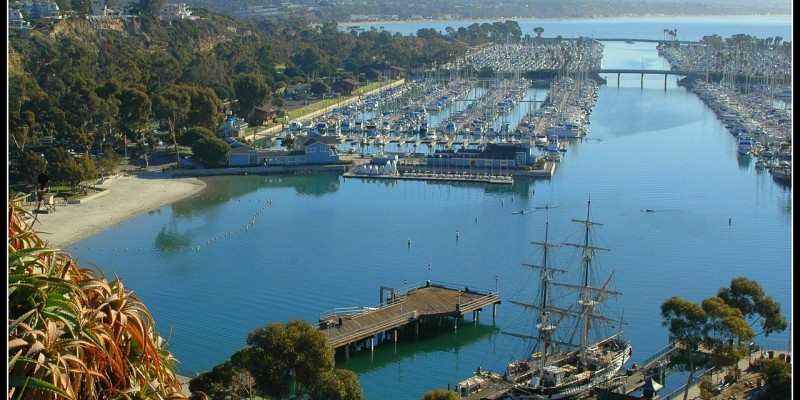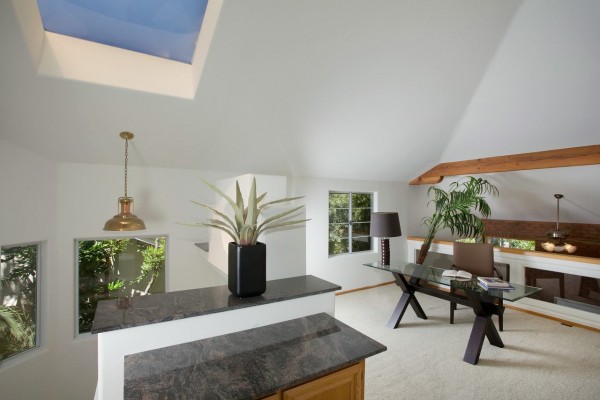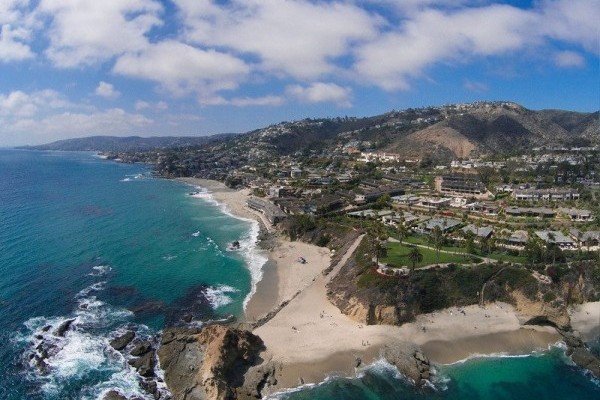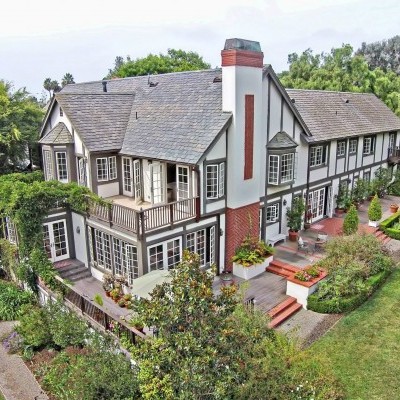
DANA POINT CA
Date: 09/27/2015
Dana Point is a city located in southern Orange County, California. The population was 33,351 at the 2010 census. It has one of the few harbors along the Orange County coast, and with ready access via State Route 1, it is a popular local destination for surfing.
The city was named after the headland of Dana Point, which was in turn named after Richard Henry Dana, Jr., author of Two Years Before the Mast, which included a description of the area. Dana described the locale, including neighboring San Juan Capistrano, as "the only romantic spot on the coast". Although Dana described the anchorage as poor, it is now a developed harbor and contains a replica of his ship, the Pilgrim. The Pilgrim is used as a classroom by the Ocean Institute, which is located at the harbor. This area is designated California Historical Landmark #189.
History
Dana Point
Dana Point was a popular port for ships involved with the hide trade with nearby Mission San Juan Capistrano. Trading reached its peak in the 1830s and 1840s. In 1818, Argentine sailor Hippolyte de Bouchard anchored there while conducting his raid on the mission. Richard Henry Dana then visited the area in 1835 while serving aboard the sailing brig Pilgrim on her voyage along the California coastline.
In 1923, Los Angeles Times publisher Harry Chandler and General M. H. Sherman, director of the Pacific Electric Railway Company, created a major real estate group to develop what is known today as the Hollywood Hills. Sidney H. Woodruff, already a prominent Los Angeles homebuilder, was hired to lead the project.
In 1926, Woodruff, Chandler, and Sherman created the Dana Point Syndicate. They invited other investors, company presidents, movie producers, and real estate investors to join them in purchasing 1,388 acres (5.6 km2) of land, some of which includes the "Headlands" of today. Promising tree-lined and paved streets, electricity, telephones, sidewalks, water mains, storm drains, sewers, and other amenities, Woodruff built 35 homes and a number of commercial buildings.
Most of these "Woodruff" houses are concentrated in the Dana Point historic core, also called Lantern Village (currently about 12,000 residents). The streets are named after different colored lanterns%uFFFDStreet of the Violet Lantern, Blue Lantern, etc.%uFFFDbecause colored lanterns were used by ships 200 years ago to advertise their fares when in the Dana Point natural harbor.[citation needed] His crowning structure was to be the Dana Point Inn, a Mediterranean-like resort hotel on the cliffs overlooking the harbor. After a celebratory groundbreaking in 1930, a three-story foundation was poured and a 135-foot (41 m) shaft was dug for an elevator to transport hotel guests to and from the beach. The economic downturn of the Great Depression caused construction to halt, however. Although Woodruff continuously sought financial support through the years, this project was abandoned in 1939. Subsequently, he sold the remaining holdings of the Dana Point Syndicate. Thirty-four of the original Woodruff residences are still occupied.
Dana Point Harbor
The harbor is home to a marina, shops, and restaurants, and it is a point of departure for the Catalina Express, a transportation service to and from the City of Avalon on Catalina Island. The entire harbor of Dana Point, including the Embarcadero Marina shops and restaurants are set for complete demolition and redevelopment. The current vintage nautical style is being abandoned for a Tech Minimalist concept using metal roofs as well as Minimalist landscaping.
Strands
The Strands is a new luxury housing development built on an old public beach and surfer hot spot next to the Salt Creek and the Ritz Carlton. Lots are rectangular with modern houses. It is a very upscale development with house sales commonly priced above $3,000,000. Sales have been rapid according to the development website. The development has made it slightly more difficult for surfers to access the water, but there has been no noticeable decrease in the surfing population.
Capistrano Beach
In 1928, a corporate entity of the American industrial giant Edward Doheny, who had built his fortune in oil production in Southern California and Mexico, purchased a number of lots in Capistrano Beach. Doheny's son, Ned, formed a development company, the Capistrano Beach Company, which included his wife's twin brothers, Clark and Warren Smith, and Luther Eldridge, a contractor, to build a community of Spanish style houses. According to Dana Point historians Baum and Burnes,* Eldridge favored two dominant characteristics in his homes, a typically Spanish roof line and the use of large ceiling beams in the main rooms of the houses. The roofline, covered with red ceramic tiles, incorporated a low-pitched gable, spreading out to one short and one long roof. The ceiling beams were decorated with stenciled artwork painted by artist Alex Meston. Eldridge was able to complete the original Doheny family house on the bluffs, four houses on the beach, and 18 other homes scattered throughout the area before tragedy struck the ambitious project. Edward Doheny was preparing for his criminal trial for bribery in the Teapot Dome Scandal, and on February 16, 1929, Ned Doheny and, Hugh Plunkett, his friend and secretary, who were to testify in the trial, were killed in a murder that still remains unsolved. In 1931, as a memorial to Ned, Petroleum Securities Company, Doheny's family-owned business, made a gift of 41.4 acres (168,000 m2) to the State of California, which is now Doheny State Park. The unimproved Capistrano Beach properties passed back to Edward Doheny, and, upon his death in 1935, to his wife and heirs. By 1944, all of the properties had been sold to private parties.
The Doheny family also funded the building of the what was then called St. Edward's Chapel in Capistrano Beach. The chapel soon grew, received canonical status as a parish, and moved to its current bluff-top location in Dana Point, overlooking Doheny State Beach.
Surfing
Richard Henry Dana (the author of "Two Years Before the Mast") considered the high bluffs and sheltered coves of this area of Southern California to be the most beautiful spot on the California coast. Pioneering surfers agreed, as they surfed the many beach breaks along the coast. Dana Point had a notable surfing history, and was home to many of the first companies that produced products for surfing. Hobie Alter opened the world's first retail surf shop in Dana Point in 1954. Many surf publications such as the Surfer's Journal and Surfer Magazine were formed and headquartered in Dana Point. Bruce Brown produced the iconic surfer film Endless Summer in Dana Point.
"Killer Dana" was a legendary surf break off Dana Point. The surf break was notorious because it came out of deep water and broke close to the rocks that lined the beach. The Killer Dana wave was destroyed when the Dana Point Harbor was built in 1966. A breakwater now cuts right through the heart of the once epic surf spot. In 1997, the surf group The Chantays recorded an instrumental track named "Killer Dana".


























